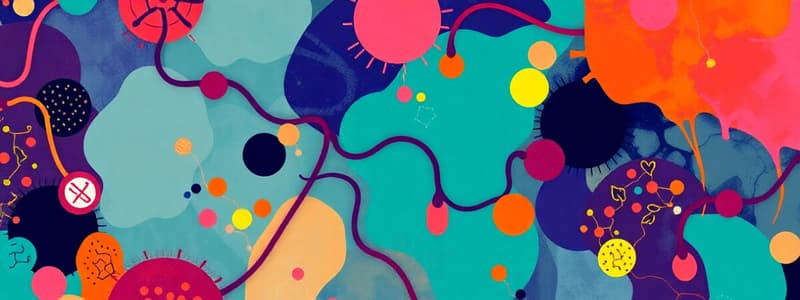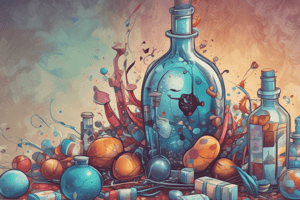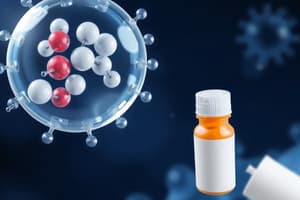Podcast
Questions and Answers
What is the fastest route of administration for drug absorption?
What is the fastest route of administration for drug absorption?
- Intravenous injection (correct)
- Oral administration
- Intramuscular injection
- Inhalation
Which characteristic of a drug molecule enhances its ability to cross the blood-brain barrier?
Which characteristic of a drug molecule enhances its ability to cross the blood-brain barrier?
- Lipid solubility (correct)
- Water solubility
- Large size
- High molecular weight
What role do enzymes play in drug metabolism?
What role do enzymes play in drug metabolism?
- They can deactivate drugs and transform them into active versions. (correct)
- They increase the concentration of drugs in the bloodstream.
- They solely excrete drugs from the body.
- They enhance the drug's effectiveness.
What do dose-response curves illustrate?
What do dose-response curves illustrate?
Why is it important to note that a given drug can have more than one effect?
Why is it important to note that a given drug can have more than one effect?
What is the primary role of norepinephrine in the brain?
What is the primary role of norepinephrine in the brain?
Where is the major source of norepinephrine located?
Where is the major source of norepinephrine located?
Which of the following best describes the receptors for norepinephrine?
Which of the following best describes the receptors for norepinephrine?
What amino acid is serotonin synthesized from?
What amino acid is serotonin synthesized from?
Which major functions does serotonin regulate?
Which major functions does serotonin regulate?
What type of neurotransmitter is glutamate classified as?
What type of neurotransmitter is glutamate classified as?
Which neurotransmitter is primarily associated with mood regulation?
Which neurotransmitter is primarily associated with mood regulation?
What is the primary function of GABA in the central nervous system?
What is the primary function of GABA in the central nervous system?
Which ion channels are NMDA receptors primarily coupled with?
Which ion channels are NMDA receptors primarily coupled with?
Which of the following neurotransmitters is associated with learning and memory?
Which of the following neurotransmitters is associated with learning and memory?
What are endogenous opioids primarily involved in?
What are endogenous opioids primarily involved in?
What role does norepinephrine play in the central nervous system?
What role does norepinephrine play in the central nervous system?
Which of the following neurotransmitters is NOT an amino acid?
Which of the following neurotransmitters is NOT an amino acid?
What does the Margin of Safety refer to?
What does the Margin of Safety refer to?
What describes tolerance in relation to repeated drug administration?
What describes tolerance in relation to repeated drug administration?
Which of the following is a feature of an agonist?
Which of the following is a feature of an agonist?
What occurs when a competitive antagonist is present?
What occurs when a competitive antagonist is present?
Which neurotransmitter's production can be affected by L-DOPA?
Which neurotransmitter's production can be affected by L-DOPA?
What is one consequence of withdrawal symptoms after stopping a drug?
What is one consequence of withdrawal symptoms after stopping a drug?
What role does botulinum toxin play in neurotransmitter release?
What role does botulinum toxin play in neurotransmitter release?
How do drugs primarily affect neurotransmitters?
How do drugs primarily affect neurotransmitters?
What is the primary function of GABA as a neurotransmitter?
What is the primary function of GABA as a neurotransmitter?
Which of the following neurotransmitters is associated with mood regulation?
Which of the following neurotransmitters is associated with mood regulation?
What distinguishes lipid neurotransmitters from others in terms of their production?
What distinguishes lipid neurotransmitters from others in terms of their production?
What type of receptor do endocannabinoids primarily act upon?
What type of receptor do endocannabinoids primarily act upon?
Which neurotransmitter class includes substances that generally enhance synaptic transmission and are involved in memory?
Which neurotransmitter class includes substances that generally enhance synaptic transmission and are involved in memory?
Which of the following is a function associated with norepinephrine?
Which of the following is a function associated with norepinephrine?
What effect does THC have in the context of cannabinoid receptors?
What effect does THC have in the context of cannabinoid receptors?
Which neurotransmitter is primarily responsible for excitatory signaling and is critical for memory formation?
Which neurotransmitter is primarily responsible for excitatory signaling and is critical for memory formation?
Flashcards are hidden until you start studying
Study Notes
Principles of Psychopharmacology
- Pharmacokinetics is the study of how drugs move through the body.
- There are four stages of pharmacokinetics: absorption, distribution, metabolism, and excretion.
- Routes of administration affect the speed of absorption and blood levels of drugs.
- Intravenous injection is the fastest route of administration.
- Most psychoactive drugs exert effects on cells of the central nervous system (CNS).
- To exert effects, drugs must pass through the blood-brain barrier.
- Lipid-soluble, small, and neutral drug molecules more easily pass through the blood-brain barrier.
- Most drugs are metabolized and deactivated by enzymes in the brain and liver.
- All drugs are eventually excreted, primarily by the kidneys.
- Sometimes enzymes transform drug molecules into active versions (e.g., benzodiazepines).
- A given drug can have more than one effect (e.g., morphine).
- Drugs can produce the same effects through different mechanisms (e.g., analgesia).
- Drug effects vary with dose.
- Margin of Safety is the difference between the therapeutic dose and the toxic dose.
- Tolerance refers to a decrease in drug effectiveness, requiring higher doses for the same effect.
- Sensitization refers to a drug becoming more effective over time.
- Withdrawal symptoms occur when an individual stops taking a drug and are usually opposite to the drug's effects.
- Withdrawal symptoms indicate physical dependence.
Sites of Drug Action
- Pharmacodynamics is the study of how drugs work.
- Most psychoactive drugs act by altering the actions of neurotransmitters.
- Agonists facilitate the action of a neurotransmitter.
- Antagonists block or decrease the action of a neurotransmitter.
Production, Storage, and Release of Neurotransmitters
- L-DOPA is a precursor for dopamine (agonist) and influences production.
- Reserpine prevents storage of monoamines (antagonist).
- Botulinum toxin blocks the release of acetylcholine (antagonist).
Action on Receptors
- Direct effects: Drugs bind to the same receptor as the neurotransmitter.
- Direct agonist: Mimics the action of the neurotransmitter when it occupies the receptor (e.g., nicotine).
- Competitive antagonist: Competes with the neurotransmitter for the same binding site but blocks its action (e.g., chlorpromazine).
Classes of Neurotransmitters
- Amino acids (glutamate, GABA), acetylcholine, monoamines, peptides, and lipids are classes of neurotransmitters.
Neurotransmitters
- Many different neurotransmitters exist.
- Most brain regions involve a balance of glutamate (excitatory) and GABA (inhibitory).
- Other neurotransmitters are found in pathways and modulate brain areas.
Amino Acids
- Glutamate is the main excitatory neurotransmitter.
- GABA is the main inhibitory neurotransmitter.
- Glycine is an inhibitory neurotransmitter in the spinal cord and lower brain stem.
Glutamate
- All sensory neurons release glutamate (except pain).
- Glutamate is stored in vesicles and released by presynaptic neurons during an action potential.
- Three ionotropic receptors for glutamate: NMDA, AMPA, and Kainate receptors. These receptors activate positively charged ion channels (Na+ , Ca++) and cause local EPSPs (excitatory post-synaptic potentials).
- One metabotropic receptor for glutamate (auto-receptor).
NMDA Receptor
- Is chemical and voltage-gated.
- Involves a Ca++ channel.
- Has multiple binding sites, including glutamate and glycine.
- Has a Mg++ binding site deep within the ion channel.
Norepinephrine
- Found in the brain and peripheral nervous system.
- Nearly all brain areas receive norepinephrine from pathways originating in the pons.
- The locus coeruleus is the major source of norepinephrine.
- Norepinephrine leads to increased vigilance (attentiveness to environmental stimuli).
- All norepinephrine receptors are metabotropic.
- Two families of norepinephrine receptors: α and β.
- Termination of norepinephrine: catabolic enzymes (MAO or COMT) and re-uptake.
Serotonin
- Synthesized from tryptophan (amino acid).
- Plays a role in mood regulation, control of eating, sleep, and arousal, and pain regulation.
- Also involved in dreaming.
- The major source is the raphe nuclei of the midbrain, pons, and medulla.
- Released from varicosities along the axons.
- At least 7 types of serotonin receptors: 5-HT1, 5HT2, etc.
Lipids
- Appear to be synthesized on demand, produced or released as needed.
- Not stored in synaptic vesicles.
- Endocannabinoids (anandamide) are the best-known lipid neurotransmitters.
- Involved in pain regulation, appetite.
- Act as retrograde signals, released by post-synaptic neurons back onto pre-synaptic neurons.
- Two types of cannabinoid receptors: CB1 and CB2.
- CB1 receptors are located on pre-synaptic nerve terminals and decrease the activity of the pre-synaptic neuron.
Naloxone
- Is a competitive opioid receptor antagonist used to reverse opioid drug overdose.
Studying That Suits You
Use AI to generate personalized quizzes and flashcards to suit your learning preferences.




